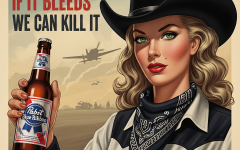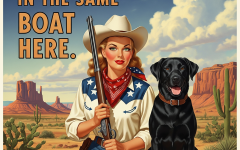illphated
The printing press at the Addison Gazette hummed with a weary rhythm, its metallic clatter a constant soundtrack to the anxieties of 1943. Maggie, her blonde curls escaping the confines of her bandana, watched as Old Man Hemmings carefully lifted the freshly printed poster. This one was different. It lacked the fiery defiance of her previous “Victory Cowgirl” campaigns. This one was…reflective.
The image was familiar: Maggie in her black Stetson, her striking green eyes holding a thoughtful gaze, a bottle of Pabst Blue Ribbon held casually in her hand. But instead of a call to arms, the bold lettering proclaimed: “EVERY BOOK IS WRITTEN IN THE PAST.”
A few townsfolk, stopping by the Gazette to get their weekly news and a glimpse of Maggie, murmured in confusion. “What’s that supposed to mean, Maggie?” Mrs. Gable asked, her brow furrowed. “Is it about remembering history?”
Maggie smiled gently. “It’s about a lot of things, Mrs. Gable. It’s about why we’re fighting. We’re fighting for the future, for the stories that haven’t been written yet. But those stories will be built on the lessons, the sacrifices, the very history we’re living through now.”
Old Man Hemmings, wiping ink from his hands, nodded in agreement. “It’s about perspective, folks. Everything we read, everything we learn, it comes from what’s already happened. And right now, we’re making history ourselves. We need to remember that, even in the thick of it.”
This poster wasn’t about rallying troops or fueling immediate action. It was a quiet contemplation, a pause for thought in the relentless churn of wartime propaganda. Maggie had suggested the slogan herself, inspired by a passage she’d read in a worn copy of “Little Women,” a book that felt like a relic from a more peaceful time. The idea had struck her – that even amidst the chaos, the future was being shaped by the present, just as every present was shaped by the past.
The poster found a different kind of resonance in Addison. It wasn’t plastered on factory walls or waved at departing soldiers. Instead, it appeared in more personal spaces: tacked to the bulletin board of the town’s small library, pinned above the desks of students diligently studying their history lessons, tucked into letters sent to loved ones overseas.
One evening, Maggie received another letter from Jimmy. This one was shorter, more introspective. He wrote about the endless monotony of ship duty, the vastness of the ocean, and the strange feeling of being disconnected yet deeply connected to home. At the end, he’d simply written, “That new poster… it makes you think, doesn’t it? We’re living a story right now. Hope it’s one worth reading someday.”
Maggie reread his words, the lamplight casting a warm glow on the poster hanging above her own small writing desk. The war was a brutal present, etching itself into the past with every passing day. But she held onto the hope that the future, the unwritten pages, would tell a story of resilience, of courage, and of a peace hard-won. This poster, in its quiet way, was a reminder of that enduring hope, a gentle nudge to remember the significance of the present moment, even as it inevitably became history. In Addison, the “Victory Cowgirl” wasn’t just a symbol of immediate strength; she was also a quiet voice urging reflection on the enduring power of the past in shaping the future.
EmailURL







k9gz9n
a6sk7a
2pgcrx